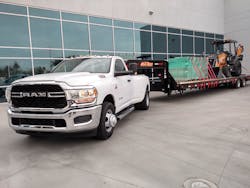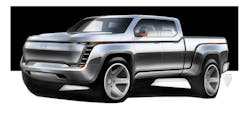In late winter and early spring, a decade of uninterrupted prosperity was interrupted by the coronavirus pandemic. Its outcome was not known as we prepared this article, but is probably becoming clear as you read this. Most likely, the crisis is subsiding as the illness fades away and business is rebounding as citizens emerge from their homes, where they huddled to avoid spreading or contracting the virus, and return to their jobs. That should include the business of designing, building, and selling pickup trucks, this country’s favorite work-and-play vehicle.
And what impressive trucks they have become. Full-size pickups have grown bigger, more capable, and more fancy, and if all that doesn’t add up to better, there are midsize and compact pickups that can suit the many operations and companies that employ them. Midsize pickups disappeared about nine years ago as the Dodge/Ram Dakota, Chevrolet/GMC Colorado/Canyon, and Ford’s compact Ranger were withdrawn due to lagging sales. But General Motors brought back its improved and slightly larger middies several years ago and that market reawakened. Ford has reintroduced a larger Ranger, and FiatChrysler is rumored to be preparing a revived Dakota, while in the meantime bringing out a Gladiator pickup version of its Jeep Wrangler. Compact pickups from Nissan (the Frontier) and Toyota (the Tacoma) continued their limited popularity, albeit with relatively few changes.
The full-size pickup trucks do most serious work, and their sales in those heady years grew steadily. In 2019, the domestic Big Three manufacturers sold 2,338,114 such trucks, according to Good Car Bad Car’s statistics compilation. Ford as usual dominated the market with 896,526 Ford F-series and Ranger pickups; Ram surged into second place by selling 633,694; and Chevrolet fell to third with 575,569 Silverado sales (but if we include GMC Sierra sales of 232,325, then General Motors remains in second place with 807,894 full-size pickups sold). Toyota sold 72,369 Tundras and Nissan eked out 31,514 Titans. Not so incidentally, Ford’s F-150 was America’s single best-selling motor vehicle of any kind for the 43rd year in a row.
“It was a great year for medium-duty and Super Duty,” said Nathan Oscarson, truck brand manager for Ford Fleet and Commercial. “2019 was up over 2018. This year started well, but now we’ve got to scramble. It depends on how fast we get through this virus thing.” In March, at the NTEA Work Truck Show, other executives touted Ford’s long-term sales dominance in most light- and medium-duty segments, with Class 6 and 7 F-series sales increasing. Ford’s perennial leadership in pickups and other truck types is due to constant product improvement and innovation, executives have said.
Ram’s triumph over Chevy for second place in pickup truck sales wasn’t celebrated much, according to Dave Sowers, head of the Ram Truck brand. “We need to make it a trend,” he said. “The mentality around here is, we need to get back to work.” Still, he and his colleagues could smile because light duty, with new and classic versions of the 1500 series pickups, was up 16 percent, and overall Ram sales, including vans, were up 18 percent over last year.
“Sexy stuff,” the high-content products, did well in winning over high-end customers, “but we also sold hard-working trucks to hard-working people” in the commercial segment, he said. For them, Ram updated Heavy Duty pickups that it brought out last fall for the current model year. Among trends he continues to see among commercial customers is interest in accident-avoiding safety features, for two reasons: to protect the public and the trucks’ drivers, and to protect the truck. Injuries and deaths are tremendously expensive, and studies show a crippled truck can cost its owner up to $2,000 a day in lost revenue.
The United Auto Workers strike against GM didn’t help in the sales war, said Dan Tigges, the corporation’s product manager for full-size pickups; nor did “aggressive pricing” by Ram. Fortunes of Chevrolet, GM’s designated commercial brand, and GMC, the upscale brand, should improve with two largely new series: the 1500 for 2019, along with continued assembly and sales of the older 1500 series, and Heavy Duty for 2020. They will carry over into 2021 with improved safety features that can save owners money.
“They have been well-received,” Tigges said, and GM’s HD pickups plant in Flint, Michigan, was “working through a long order backlog,” at least until the coronavirus caused production interruptions to protect workers (a move implemented by other manufacturers, too). Both the 1500 and 2500/3500 pickups are bigger because “we’re building what customers want,” he said. Larger cabs mean more room, especially for commercial customers who use their trucks as offices.
Diesel versus gasoline is a question that buyers of all pickup truck makes face every year, and lately the trend seems to be swinging toward gas. Ford’s Oscarson, Ram’s Sowers, and GM’s Tigges all observed that the price premium for a diesel has gone up since exhaust-emissions limits have grown more stringent. Developing exhaust-gas recirculation systems and exhaust aftertreatment equipment has been tremendously expensive, and anti-pollution regulations are growing more strict. The cost differential for a larger diesel pickup is $8,000 to $11,000—though a smaller diesel in a 1500 series pickup can be far less. At the same time, a gallon of diesel fuel is $1 to $1.50 more than gasoline. Oil prices plunged and gas prices dropped below $2 per gallon in many parts of the country as talks on production limits among OPEC countries failed, and Saudi Arabia and Russia began a market-share war.
The builders saw the trend toward gasoline developing and each fielded larger gasoline engines to supplement diesels. Ford’s 7.3-liter gas V-8 is becoming popular in Super Duty pickups and cab-chassis models, Oscarson said; GM’s new 6.6-liter gas V-8 has “amazing performance,” Tigges said; and Ram’s 6.4-liter gas V-8, introduced several years before, has caught on in many applications, said Sowers. It used to be that diesels lasted longer and delivered substantially better fuel economy, but gasoline engines now routinely run 200,000 miles and more, and direct-injection fuel systems have reduced fuel use while working or at idle (though in some cases direct injection complicates conversions to propane or natural gas). Gasoline engines cost less to maintain, because they’re easier to work on and consume less motor oil at drain time. Diesel is still the way to go where mileage is high and heavy loads are frequently carried or pulled. Thus the heavier the pickup truck, the more likely it is to be a diesel.
One diesel no longer available is the 5-liter Cummins V-8 that was optional in Nissan’s Titan XD pickup. Cummins had high hopes for the engine, but Ram, its hoped-for customer, tested it and found that fuel economy was too low; then Chrysler merged with Fiat, which sourced the Italian V-6 EcoDiesel for the Ram 1500. Other possible business also failed to materialize, and Nissan ended up being the only customer for the engine. Customers reported a variety of problems and Nissan sold few, so it discontinued the engine. Cummins stopped production of the diesel V-8 in December. Nissan appears to be struggling with the Titan’s low sales and some observers say the full-size pickup is on a “death watch.” As it has in prior years, Nissan reserved space in the 2020 Work Truck Show in Indianapolis, but canceled before it opened. Spokesman Kevin Raftery said this was for “budgetary reasons,” but that Nissan remains committed to the commercial market even as it pursues more retail business.
When will electric pickup trucks be available?
For some uses, electric pickup trucks are the future, and the future is close. Electric cars and trucks were some of the first vehicles sold in the early 20th Century, and only the limitations of primitive batteries caused them to be pushed aside by more flexible gasoline engines. Class 8 electric trucks are now in the works and could be hauling revenue freight within a few years. Builders have announced that a few prototypes are already at work, picking up trash in New York City and several locales in Europe.
Any local operation could use modern electric pickup trucks because they return home often for recharging, and electric charging stations are proliferating. Regenerative braking, which occurs often in the stop-and-go of local operations, helps recharge batteries, and continuing advances in battery technology will stretch range to useful levels. Series production of electric pickup trucks will begin this year, a few manufacturers say.
Electric pickups, like all electric vehicles, or EVs, will be clean, quiet, and quick. They will cost more to buy than gasoline- or diesel-powered trucks; but EVs will have far fewer moving parts and thus be less expensive to maintain, and their total cost of ownership will be less, proponents say. Experts caution that the EV industry needs to standardize on equipment specifications, such as plugs and charging stations. And public utilities must prepare to generate the many megawatts needed to recharge the batteries of EVs, and/or help set up local solar- and wind-powered generators to supplement power available from the grid. Those challenges will be overcome if there’s customer demand and money to be made, and apparently there will be, if industry interest and public curiosity are any indication.
Much media attention fell on the unveiling of Tesla’s Cybertruck, the wedge-shaped, stainless steel-bodied pickup introduced last December by the company’s forward-thinking founder, Elon Musk. The event was covered on television news shows and by auto magazines and internet commentators, and the vehicle drew praise and criticism for its futuristic, even untruck-like styling. Cybertruck will come in three variants: with one, two, and three motors in rear- and all-wheel drive, priced at $49,900 to $69,900. Range will be 250-plus miles, payload up to 3,500 pounds, and towing capacity will be 14,000 pounds or more. The company is taking refundable $100 deposits on orders for Cybertrucks, which it says will enter production late next year for higher-end models and 2022 for the single-motor version. The pickup will join four car models in Tesla’s lineup, so overall, Elon Musk and his company have earned some automotive credibility.
If money buys credibility, Rivian, a Detroit-area start-up firm, has earned some of it with more than $1.6 billion in funding from well-known companies, including Ford. Rivian was preparing an R1T pickup truck and an R1S sport-utility vehicle, and appears to be after retail rather than commercial sales. Its “skateboard” chassis includes a quad-motor system, with a motor at each wheel to provide all-wheel-drive traction and allow it to do a “tank turn,” or spin in a small circle. Air suspension and hydraulic roll control will actively react to vehicle movement over varying terrain, and three battery pack sizes will give it ranges of 230 to 400-plus miles. Payload rating is 1,760 pounds and towing capacity is 11,000 pounds. Starting price for an R1T is $69,000, but options are expected to raise prices toward $100,000. Rivian is taking $1,000 deposits on “pre-orders,” and says it will start production later this year.
Ford has a worldwide EV program that includes cars, SUVs, and trucks. It is readying an all-electric F-150 that it says will be announced next year as a ’22 model. As a teaser, it released a video showing a prototype pulling 10 loaded auto-rack rail cars weighing more than 1 million pounds. Of course, that won’t be its tow rating, because steel wheels roll rather easily on steel rails, but it still takes considerable torque to move a string of railroad cars. In March, Ford showed off an electric Transit van, whose components could be similar to an F-150’s. It has invested $500 million in Rivian, and the two formed a partnership that is jointly developing the electric F-150. It could use Rivian’s skateboard platform, the two firms said in a statement.
GMC showcased its Chevy E-10 electric pickup.
General Motors is helping Lordstown Motors Corp., a company begun by Steve Burns, the founder and former CEO of Workhorse Group— a maker of walk-in vans—and staffed by executives lured from other automotive manufacturers, including Tesla. LMC says it is testing prototypes of its Endurance electric pickup (above), originally developed by Workhorse and licensed from it. LMC plans to begin building them this November in the former General Motors assembly plant in Lordstown, Ohio. In addition to selling the huge plant for a modest $20 million, GM has loaned LMC $10 million and might lend more, and is talking about leasing space in the plant for a battery-manufacturing operation. Endurance will be all-wheel drive with a motor at each wheel, and is billed as a work truck aimed primarily at fleets. LMC has priced the Endurance at $52,500 and says it could eventually build close to 400,000 per year. It has received a preliminary order for 500 from Clean Fuels Ohio, a nonprofit clean-fuels organization that says it will deploy them with businesses across the state as an “education” effort. LMC meanwhile is taking pre-orders from the public with $100 deposits.
Finally, Bollinger Motors, another Michigan-based startup, is preparing a B1 electric SUV and a B2 pickup that it says will have exceptional off-road capabilities. Styling forsakes aerodynamics for squared-off, Range Rover-like profiles that would be at home in rough country.
Hybrid pickup trucks returning
Gasoline-electric hybrids are a stepping stone to fully electric trucks because they allow users to become accustomed to electric power and they have no range restrictions. GM developed a gasoline-electric SUV in the mid-2000s but didn’t sell many, so pulled it from the market. Today, Ford is working on a hybrid-electric F-150 that it will introduce this fall as a 2021 model, but will otherwise say nothing about it. Ford-based hybrids are available now from at least one source, XL Fleet. The Boston-based company introduced a hybrid conversion for Ford’s F-250 pickup in 2017 and has long made bolt-on conversions for General Motors vans and cutaway chassis. In March, XL announced a version for Chevrolet Silverado 2500 and 3500 pickups. As with previous products, the system assists a truck’s powertrain in propulsion, especially from startup. It uses its own electronic controls and does not connect with the truck’s. The XL system is composed of a motor mounted in the driveline, a battery pack, and the controls. Installation takes about a day and is done by upfitter partners. XL promises a 25 to 30 percent fuel economy improvement and emissions reduction of 20 percent.







